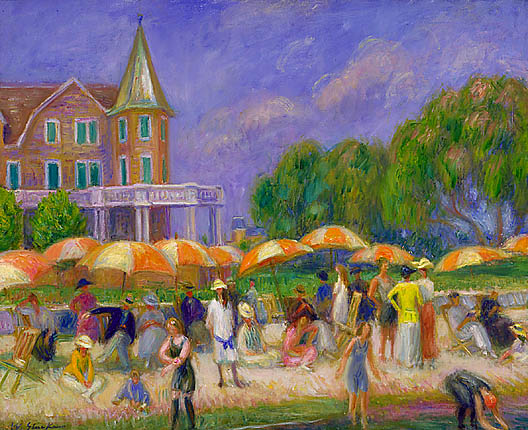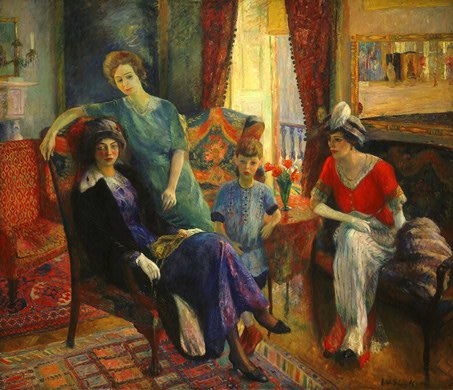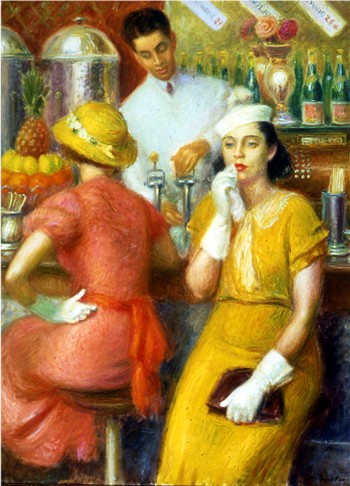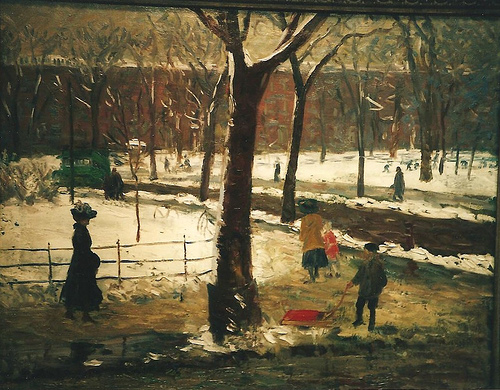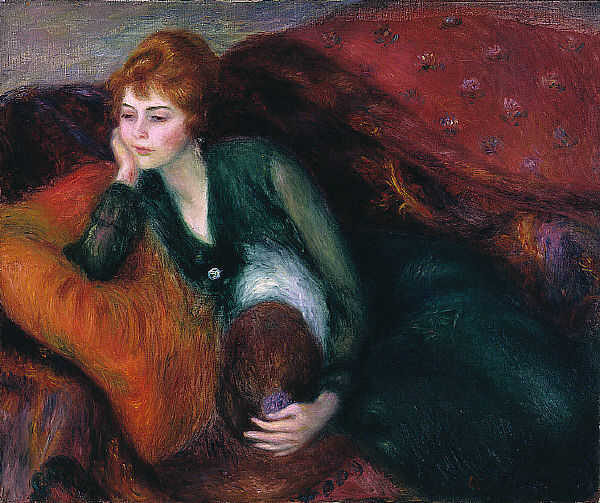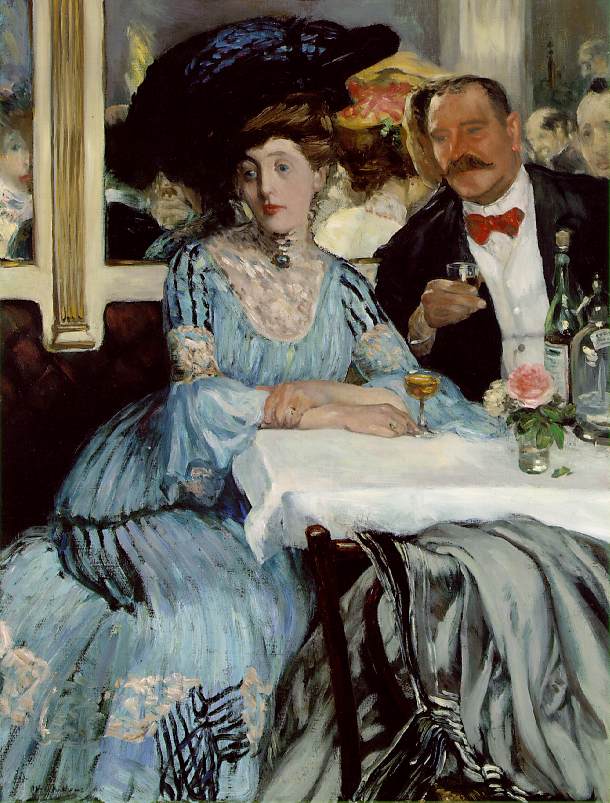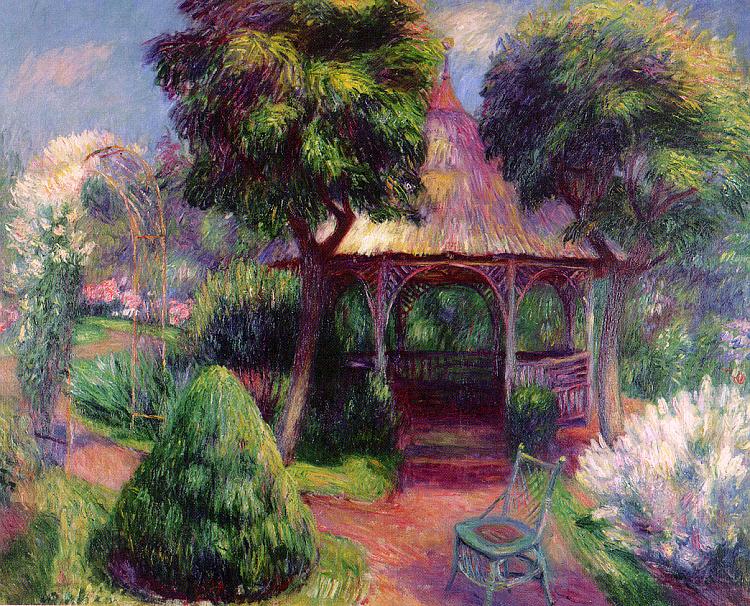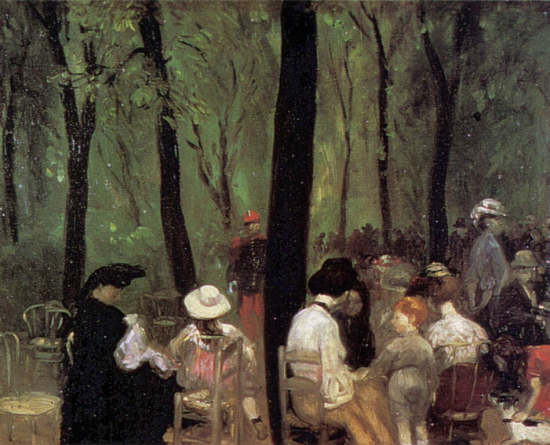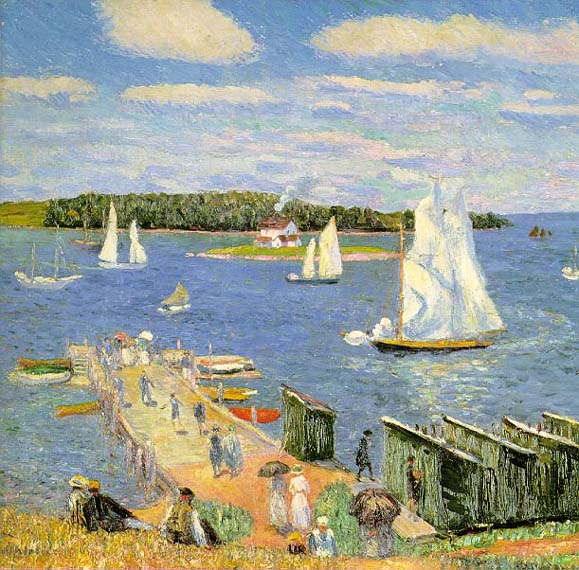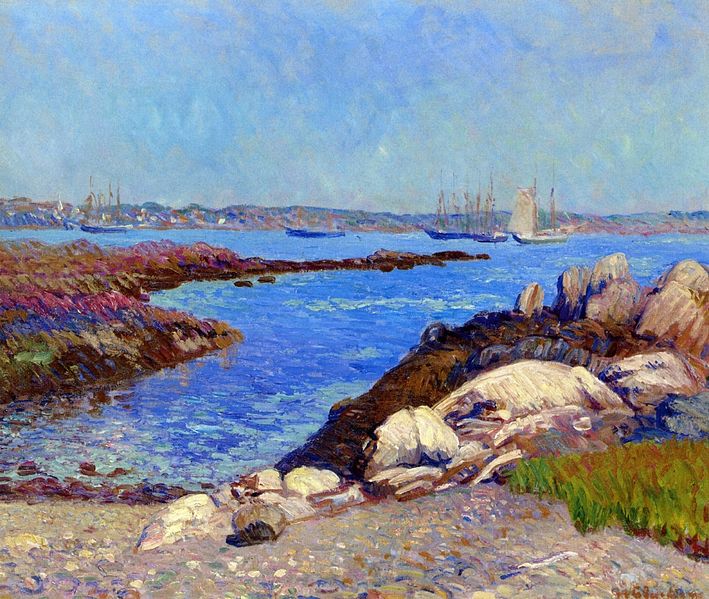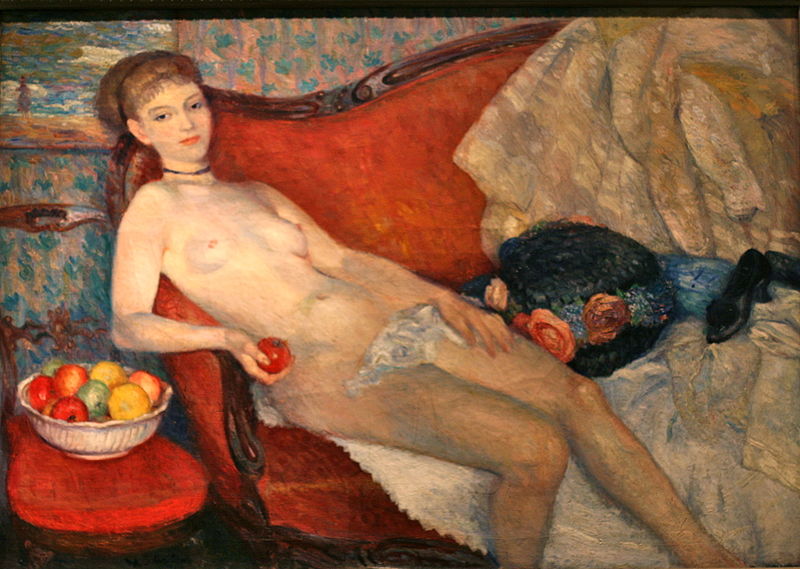<Back to Index>
- Painter William James Glackens, 1870
PAGE SPONSOR


William James Glackens (March 13, 1870 – May 22, 1938) was an American realist painter.
Glackens studied at the Pennsylvania Academy of the Fine Arts and later moved to New York City, where he co-founded what came to be called the Ashcan School art movement. This group of artists, dubbed by the press "the Eight Independent Painters" or The Eight, chose to exhibit their works without pre-approval by the juries of the existing art establishment. He became known for his dark - hued paintings of street scenes and daily life in the city's neighborhoods. His later work was brighter in tone, and showed the influence of Renoir. During much of his career as a painter, Glackens also worked as an illustrator for newspapers and magazines in Philadelphia and New York City.
Glackens was born in Philadelphia, Pennsylvania, where his family had lived for many generations. His father Samuel worked for the Pennsylvania Railroad. William had two siblings — an older sister Ada, and an older brother, cartoonist and illustrator Louis Glackens. He graduated from Central High School in 1890. Throughout school he showed a great interest and aptitude for drawing and drafting.
After school Glackens became an artist - reporter for The Philadelphia Record. In 1892 he left that publication and began illustrating for the Philadelphia Press, where he covered various subjects. He then began taking evening classes at the Pennsylvania Academy of Fine Arts, studying under Thomas Anshutz. Glackens was not a steady pupil, as art critic Forbes Watson would observe in 1923: "So much impression did the various instructors make upon him that today he can hardly remember who taught there when he was a pupil." John Sloan also attended the Academy, and he introduced Glackens to Robert Henri. Henri began to arrange meetings at his studio to have discussions and give artistic criticism.
In 1895, Glackens traveled to Europe with several fellow painters, including Sloan and Henri. He first visited Holland where he studied the Dutch masters. They then moved to Paris where Glackens rented a studio for a year with Henri. Such a trip was common for artists of the time who wished to establish themselves in the art world. It was Glackens’s first trip to Paris, but for the others it was a return trip. While in Paris, Glackens painted independently, but did not attend any schools. He returned to America in 1896 to work in New York. Later in his life, Glackens returned periodically to paint in Paris and the South of France.
Upon settling in New York in 1896, Glackens attained a job as an artist for the New York World. He got this position through his friend George Luks who was also an illustrator. Glackens soon became a sketch artist for the New York Herald. He also worked for various magazines as an illustrator.
In particular, Glackens illustrated for McClure's Magazine, which sent him to Cuba to make a series of drawings covering the Spanish - American War. When he returned, Glackens continued to illustrate for magazines, although his real passion was in painting. In 1901, he exhibited at the Allen Gallery with Henri and Sloan, and began to gain notice for his artwork.
Glackens married Edith Dimock in 1904. She was also an artist, and they lived together in New York.
Glackens soon began to associate with a group of artists now known as The Eight, or the Ashcan Group. They included Robert Henri, Arthur B. Davies, Maurice Prendergast, Ernest Lawson, William Glackens, Everett Shinn, John French Sloan and George Luks. These men did not create the name themselves, but after their exhibition of 1908, it became their unofficial title. They decided to hold a separate exhibition after being continually rejected from the National Academy’s events. It was a way to reject the controlling group's rigid definition of artistic beauty. Their exhibit was well received and was sent on tour as a traveling show curated by Sloan. They gained national recognition and were invited to exhibit at many institutions. Most of the Eight also participated in the "Exhibition of Independent Artists" in 1910, an attempt to break down the exclusivity of the academy.
The Eight are known for their realist style and are considered key figures in the realist movement. They depicted urban scenes and welcomed artistic freedom. Like Glackens, they were journalists, writers, or illustrators before becoming painters. They chose to continue with the style of illustration, which emphasized immediacy as well as community and interaction. Glackens was an integral part of the group. The "genre aspects" of Ashcan art are evident in his work of the time.
Artist and friend, Jerome Myers, recalls in his autobiography "Artist In Manhattan" his visits with Glackens: "The studio home of William Glackens, on Ninth Street just off Fifth Avenue, partook of the charm of this fine, boasted period. It was a delightful privilege for my wife and me to participate occasionally in the at-homes of the Glackens during the season. Surrounded by the masterpieces of William Glackens, friends would gather in congenial remembrance: Edith Glackens, always an amusing hostess; William Glackens, quietly reminiscing with his companions. The young Glackens, Leonna and Ira, filled out the family picture, happy with their young artist friends, as well as with older friends who had known them since childhood. Of the latter were Everett Shinn and Guy Pène du Bois; Wallace Morgan and Harry Dart, both of whom worked with me in the old New York Herald art department; May Wilson Preston, the Johannsons; and many other celebrities of New York's art life, reunited in informal pleasure, the whole scene imbued with the spirit of a New York that is now passing."
By 1910 Glackens began to concentrate on a "highly personal coloristic style" instead of Ashcan ideas. His work was often compared to that of Renoir, to the point that he was called the "American Renoir". It is said that “although he identified with The Eight, who struggled to infuse a lusty spirit into a nearly moribund American art, it was for a brief time only, because his art could not develop within the limits of Ashcan philosophy.” While Glackens continued to paint in a realist style emphasizing a single moment in time and real people, his art experienced a shift that distanced him from his Ashcan comrades.
About this time, Albert C. Barnes, a classmate and friend from high school, began to study and collect art. He commissioned Glackens to buy him some "modern" works while on a trip to Paris. These 20 paintings, which included works by Cézanne, Renoir, Manet and Matisse, formed the core of what became the Barnes Foundation collection. Glackens also advised Barnes on later art movements and purchases.
In 1916, Glackens served as the president of the newly founded Society of Independent Artists. He continued to travel to France between 1925 and 1935 to study the work of the Impressionists, the Post - Impressionists, and Les Nabis, the styles of which he adapted into his work. His paintings received gold medals from annual exhibitions at the Pennsylvania Academy of Fine Arts in 1933 and again in 1936.
Glackens died in Westport, Connecticut, on May 22, 1938. His legacy is greatly linked to that of the Eight. Although having distanced himself from some of their ideals, he continued to be considered an integral part of the realist movement in American art.
Glackens's subject matter and style changed throughout his life. Influenced by the Impressionist work he saw during his stay in Europe, Glackens’s early work uses "dark, dramatic colors applied vigorous in slashing brushstrokes." He depicted scenes of urban life in Paris and its suburbs. He continued this style and subject matter for some time until he began to break away from The Eight. At that point his most common subject matter was landscapes, especially beach scenes. Later Glackens became best known for his portraits, and late in his life he focused on still lifes. Despite the changing subject matter, Glackens’s work always emphasized the reality of life and also the happiness. He "sought beauty and found it where conventional eyes saw ugliness." Watson asserts that Glackens focused on color because "the color of the world makes him thoroughly happy, and to express that happiness in color has become his first and most natural impulse." He painted because he wanted to show the beauty of the world. His paintings are "haunted by the spectre of happiness, obsessed with the contemplation of joy".
Glackens is often criticized for his similarity to Renoir. Some even call him an imitator. After the Exhibition of Independent Artists in 1910, Glackens’s style shift was quickly compared to Renoir’s style. It is said that during the 1920s and 1930s “his once vigorous artistic personality had been blunted by too close imitation of Renoir’s late style.” Glackens’s interest in color likens him most to Renoir; Watson claims Glackens to have a “rich palette akin to Renoir’s to express his pure delight in color.”
Glackens is compared to Pascin because they were both “among the best illustrators of their day”. They both used life for their subjects, and were able to see and emphasize the “humorous aspects” of life.
Nude with Apple is a signature piece of Glackens’s career. It is said to be the turning point in his style and his division with The Eight. It is a portrait of a model resting on a couch, holding an apple. Critics have called it a “modern Eve” because of its reference to the fruit. The notable attention paid to bright, vivid colors sets this painting apart from those of The Eight.
It is interesting to compare the finished work to an earlier study in pastel. Glackens's method of working would include numbers of sketches where he would focus on each element of the composition.
Chez Mouquin is arguably Glackens’s most celebrated painting. It is set in the well known restaurant regularly visited by many of Glackens' associates. The painting is a portrait of James B. Moore, a restaurant owner, who is depicted at a table with Jeanne Mouquin. He is drinking, while the lady is turned away looking uninterested. They are reflected in the mirror behind them, along with a large crowd of people in the room. The painting is often compared to those of Degas, but “the sense of despair in Degas’s picture is replaced in the Glackens by a buoyant 'joie de vivre'.” He portrays realist subject matter, the urban life, but does so with happiness and humor.
Portrait of the Artist’s Wife portrays Edith Glackens seated next to a fruit still life. It is one of many of Glackens’s portraits. He also painted likenesses of several members of The Eight. The portrait does not idealize Edith. Rather he “frankly acknowledges her pert nose and small chin.”
Collector Albert C. Barnes bought many of Glackens’s best paintings, some of which are exhibited by the Barnes Foundation in Merion. They were classmates at the academic Central High School (Philadelphia, Pennsylvania), a school which also produced John Sloan and Thomas Eakins.
